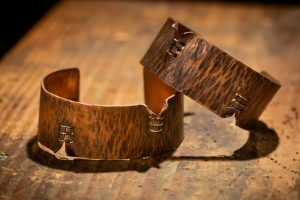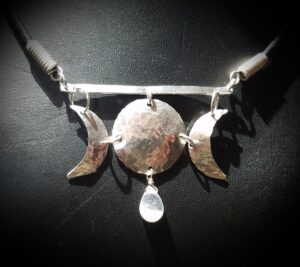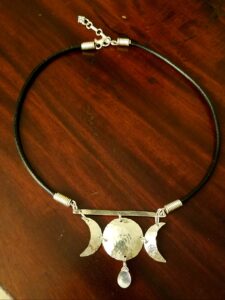The Beauty of Broken Things (Wabi Sabi)
 At a show in Nashville one year I met a woman who told me my jewelry was lovely, but that she didn’t want to try anything on because it would just call attention to the thick scars I could see marking her neck and arms. She gathered her jacket close to her and tugged her cuffs down over her hands, and my heart went out to her.
At a show in Nashville one year I met a woman who told me my jewelry was lovely, but that she didn’t want to try anything on because it would just call attention to the thick scars I could see marking her neck and arms. She gathered her jacket close to her and tugged her cuffs down over her hands, and my heart went out to her.
I felt moved to tell her about the concept of “Wabi Sabi,” a Japanese aesthetic that finds the beauty in imperfection, holding that anything that has been broken, and then repaired, is more beautiful, unique, and stronger at the broken places, and more highly prized than a piece that is deemed “perfect.” This concept is especially manifest in the art of Japanese ceramic repair known as “Kintsugi,” which incorporates a lacquer seam colored with powdered gold, silver, or platinum to highlight an object’s repair.
But the Wabi Sabi aesthetic is not just visual, it is also a world view—an outlook that reconsiders the beautiful and the imperfect. As I talked on about this remarkable cultural view that understands more deeply what should be of value than my own culture’s sometimes ridiculous notions of multi-faceted perfection, the woman began to smile. She smiled and even laughed a little as she told me about her beautiful daughter, and how she was actually looking at jewelry as a gift for her. She asked for my card before she left my booth, saying I would hear from her.
I happily gave her the card, but all artists know that asking for a business card can just be someone’s ticket out of an artist’s booth, perhaps hoping to ease their unnecessary guilt at not purchasing something. I didn’t really expect to hear from her and was surprised when her name popped up a few days later in my email. She wanted to buy a bracelet for her daughter, she said, and some earrings for herself. But mostly, she said, she wanted to thank me for telling her about Wabi Sabi. She said she was beginning to think of her scars as medals for overcoming what had been a very difficult period in her life. And she said she would forever after be looking outside of herself, too, for the beauty of broken things.
After I read her email, I went immediately to my studio and designed this cuff bracelet along with a pendant and earrings you can see on this site. As I made them, of course I thought about what she had said, and I admit to being a little weepy (which kind of made me feel silly, and I promise I wiped off all the tears). It’s just that we all want to feel like what we do is important in some way. But sometimes the life I’ve made doing this can be very hard—the sore back, the ragged fingertips, the travel, the weather conditions, the uncertainty—and I consider giving it up for something easier, and more regular. But then I meet someone like this woman who came into my booth and allowed me to share something meaningful, which in turn became her gift back to me, and ultimately informed the creation of this jewelry–a symbol meant to carry its intention forward so that it might provide a meaningful message for someone else. And I guess for me, that’s really what it’s all about—to make something that can be beautiful and meaningful not just to me, but shared with someone else. This is why I can’t help but love my customers—they give me so much. I’ve met a lot of wonderful people doing this job, so thanks for reading this, and thanks for being one of them. See you at the next show! ![]()

 In conversation with a friend who recently experienced a dramatic physical transformation, she shared that in looking so much better she finally felt worthy of a loving relationship. I wasn’t startled by this statement, probably because of its familiarity. I’ve heard it expressed in some form by a number of my women friends and unfortunately, it isn’t surprising given the value our culture places on physical looks, especially and unfairly–a woman’s looks.
In conversation with a friend who recently experienced a dramatic physical transformation, she shared that in looking so much better she finally felt worthy of a loving relationship. I wasn’t startled by this statement, probably because of its familiarity. I’ve heard it expressed in some form by a number of my women friends and unfortunately, it isn’t surprising given the value our culture places on physical looks, especially and unfairly–a woman’s looks. The night has crossed over into the wee hours, and the sky isn’t perfect for viewing. But if I look low and toward the east, I can spot just a sliver of the waning moon rising from behind a lumbering cloud. Hours ago it rained, but the welkin remnants can’t dim my excitement when I spy the thin illumination. Whatever her phase, Luna is always a comfort and company to me when she is visible, and like most, I use feminine terms to describe her. The moon is the quintessential feminal form, and when only a slim curve of it appears, I am reminded of one of the most ancient symbols associated with womanhood–waxing and waning crescents flanking a full moon–often referred to as the Triple Goddess symbol.
The night has crossed over into the wee hours, and the sky isn’t perfect for viewing. But if I look low and toward the east, I can spot just a sliver of the waning moon rising from behind a lumbering cloud. Hours ago it rained, but the welkin remnants can’t dim my excitement when I spy the thin illumination. Whatever her phase, Luna is always a comfort and company to me when she is visible, and like most, I use feminine terms to describe her. The moon is the quintessential feminal form, and when only a slim curve of it appears, I am reminded of one of the most ancient symbols associated with womanhood–waxing and waning crescents flanking a full moon–often referred to as the Triple Goddess symbol.